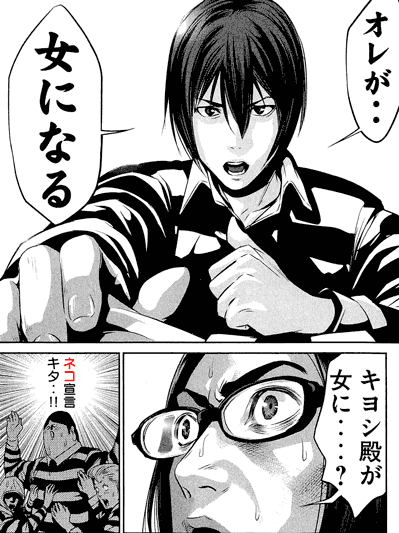In Japanese, tachi タチ, neko ネコ, and riba リバ are gay slangs for "top," "bottom," and "switch," respectively. Not to be confused with the homonyms: ~tachi ~達, the pluralizing suffix, and neko 猫, meaning a "cat," the animal.
Origin of Tachi タチ
There are a a number of theories about the origin of tachi タチ and how it came to mean "top" as a LGBT slang.(m-gay.com)
One of them is that in the world of kabuki 歌舞伎 (a sort of theater that commonly features only male actors), the actor in the leading "man role," otoko-yaku 男役, is called tachi-yaku 立ち役, "standing role." Since some people say the "top" is the "man" in a homosexual couple, the word tachi came to mean that.
Another theory is that it comes from the word tachi 太刀, a type of Japanese "long sword." That is: it's comparing the penis to a "long sword."
Another theory is that, because tatsu 起つ means "to stand up" or "to get erect," and tachi 起ち would mean "erection" (or "standing up), so it comes from that.
Origin of Neko ネコ
Likewise, there are a number of theories for why neko ネコ means "bottom" in Japanese.(m-gay.com)
One of them is that it comes from the world "wheelbarrow," which is also neko ネコ. Why wheelbarrow? Because, apparently, the way one holds a wheelbarrow is similar to the way a tachi would hold the neko's legs during intercourse.
Another theory is that it actually comes from neko 猫, "cat," because, in English, the word "pussy," from "pussycat," is a slang for vagina.
Another theory is that it comes from neruko 寝る子, "sleeping child." Although note that while ko 子 means literally "child," it's sometimes used to people regardless of age, so it's more like "sleeper." Also note that neru 寝る in this case is probably not just "to sleep" but "to sleep with." (see: netorare 寝取られ). Which means neruko 寝る子 is "someone that sleeps with someone" or "someone [you] sleep with."
Origin of Riba リバ
The word riba is likely the abbreviation of the katakanization of "reversible," ribaashiburu リバーシブル.
vs. Seme and Uke
The terms seme and uke also mean "top" and "bottom," but they're used by fujoshi in their BL (yaoi) doujinshi and fanfiction world, which means they have nothing to do with real life. In 2D, it's seme and uke, in 3D, tachi and neko. Or so was the case.
Nowadays, LGBT people started to use seme and uke IRL too, mixing the LGBT subculture with the otaku subculture.
When seme and uke are used in real life, they refer to the "assertive" and "passive," or to "dominant" and "submissive"—who takes lead and who's led in a sexual relationship—while tachi and neko (at least to gays) refer to who penetrates and who's penetrated.(m-gay.com)
The Pixiv dictionary warns the words seme and uke in BL are only about who penetrates and who's penetrated and nothing else. Which means that real-life seme-uke and fiction seme-uke have different meanings according to some, while real-life tachi-neko and fiction seme-uke are synonymous according to some.
A real-life neko-seme (bottom, but assertive) could be something like an osoi-uke in fiction.
凸凹回
This is one of the silliest things I've come across, but, apparently, in gay dating websites, the 凸凹回 kanji are used to symbolize tachi, neko and riba.
- tachi, or seme
凸
Top. Pitcher. Active. - neko, or uke
凹
Bottom. Receiver. Passive. - riba
回
Switch. "Reversible.
Normally these kanji don't mean anything sexual. Their usual meanings are:
- deko
凸
Bump. - kubomi
凹み
Dent. - totsu
凸
Convex. - ou
凹
Concave. - dekoboko
凸凹
Uneven, with dents and bumps - outotsu
凹凸 - mawari
回り
Rotation.

No comments: